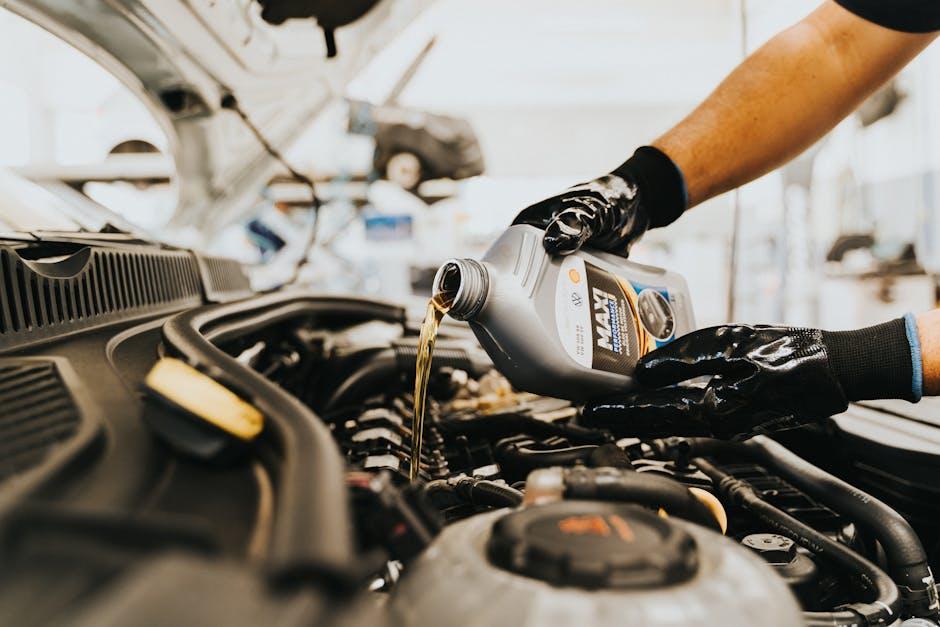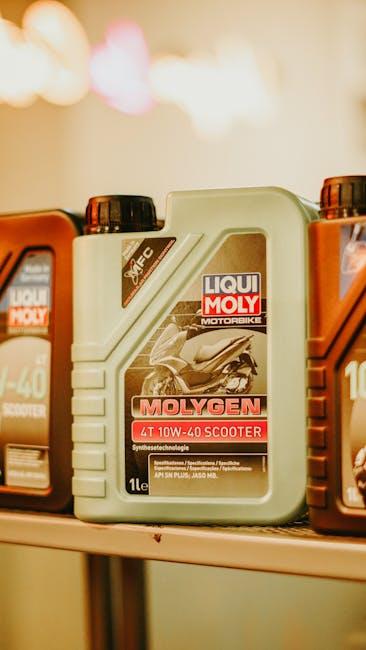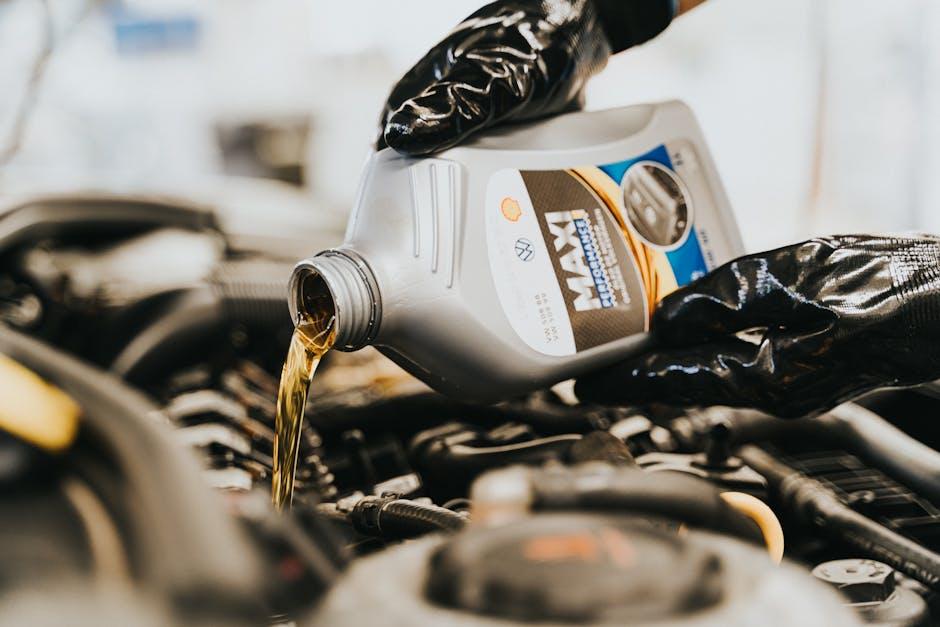Beneath the hood of every vehicle, a quiet hero works tirelessly to keep the engine running smoothly: motor oil. Acting as a lubricant, cleaner, and protector, it plays a crucial role in your car’s performance and longevity. Yet, despite its importance, many drivers find themselves asking, “How often should I change my car’s oil?” The answer is more nuanced than a simple mileage figure, influenced by factors ranging from driving habits to oil types. In this article, we’ll explore the essentials of oil changes, helping you understand when it’s time to give your engine the fresh boost it needs.
Table of Contents
- Understanding the Importance of Regular Oil Changes
- Factors That Influence Oil Change Frequency
- Decoding Your Car Manufacturer’s Oil Change Recommendations
- The Role of Driving Habits in Oil Degradation
- Choosing the Right Type of Oil for Your Vehicle
- Signs It’s Time to Change Your Car’s Oil Beyond the Mileage Guide
- Q&A
- Key Takeaways

Understanding the Importance of Regular Oil Changes
Oil is the lifeblood of your vehicle’s engine, ensuring that every component operates smoothly without unnecessary friction or overheating. Over time, oil breaks down and becomes less effective, allowing dirt and debris to circulate and potentially damage engine parts. Regular oil changes replenish this vital fluid, helping to maintain optimal engine performance and prolong the life of your car. Ignoring this essential maintenance can lead to costly repairs, reduced fuel efficiency, and even complete engine failure.
Key benefits of timely oil changes include:
- Improved engine lubrication
- Enhanced fuel economy
- Prevention of corrosion and sludge buildup
- Reduction in harmful emissions
| Oil Change Interval | Recommended Mileage | Benefits |
|---|---|---|
| Conventional Oil | 3,000 – 5,000 miles | Basic protection, affordable |
| Synthetic Blend | 5,000 – 7,500 miles | Better performance, longer intervals |
| Full Synthetic | 7,500 – 10,000+ miles | Superior protection, longevity |

Factors That Influence Oil Change Frequency
Several key elements play a pivotal role in determining how often you should schedule an oil change for your vehicle. Driving conditions are among the most influential factors — frequent stop-and-go city traffic, dusty or off-road environments, and short trips where the engine doesn’t fully warm up all accelerate oil degradation. In contrast, highway driving with steady speeds tends to be less stressful on engine oil. Additionally, the type of oil used matters; synthetic oils often boast longer lifespans compared to conventional oils, allowing for extended intervals between changes.
Another consideration is the vehicle’s age and make. Older engines might require more frequent oil changes due to wear and tear, while newer models with advanced engine technology often have manufacturer-recommended intervals that can stretch significantly. It’s also worth noting the impact of engine load — towing heavy loads or carrying extra weight increases the engine’s workload, which can break down oil faster. To help you visualize this, the table below outlines common scenarios and their typical oil change intervals:
| Driving Condition | Recommended Oil Change Interval |
|---|---|
| City Driving (stop-and-go) | 3,000 – 5,000 miles |
| Highway Driving | 7,500 – 10,000 miles |
| Heavy Load/Towing | 3,000 – 4,000 miles |
| Light Driving / Synthetic Oil | 10,000 – 15,000 miles |

Decoding Your Car Manufacturer’s Oil Change Recommendations
Car manufacturers provide oil change intervals based on extensive testing and the specific needs of your engine. These recommendations are designed to optimize engine health, fuel efficiency, and overall performance. Typically, you will find this information in your vehicle’s owner’s manual, often expressed in terms of mileage or time — whichever comes first. However, these guidelines are not set in stone; they take into account ideal driving conditions and average weather, but real-world variables like frequent stop-and-go traffic, extreme temperatures, or towing can affect how often you actually need an oil change.
When reviewing your car’s recommendations, watch for phrases such as “severe service” or “normal service,” as these categorize your typical driving habits and can influence your oil change schedule. Here’s a simplified overview of what these terms imply:
| Service Type | Driving Conditions | Oil Change Frequency |
|---|---|---|
| Normal Service | Highway driving, mild conditions | 7,500 – 10,000 miles |
| Severe Service | City traffic, stop-and-go, towing | 3,000 – 5,000 miles |
- Normal Service: Regular commutes, minimal idling, routine weather.
- Severe Service: Frequent short trips, dusty or extreme climate conditions, extensive idling.
Understanding these terms and tailoring your oil change routine accordingly can extend your car’s engine life and prevent unnecessary repairs. Always pair manufacturer’s advice with your personal driving habits for a truly customized maintenance plan.

The Role of Driving Habits in Oil Degradation
Your driving style significantly impacts how quickly your engine oil deteriorates. Frequent stop-and-go traffic, aggressive acceleration, or long idling periods elevate engine temperature and stress the oil, causing it to lose its protective properties faster than usual. In contrast, smooth, steady highway driving typically results in less oil degradation, allowing oil to maintain its viscosity and lubrication qualities for longer stretches between changes.
Consider these common driving conditions that accelerate oil breakdown:
- City Traffic: Constant starts and stops increase oil contamination.
- Short Trips: Engines rarely reach optimal temperature, causing moisture buildup.
- Heavy Loads: Towing or carrying extra weight raises engine strain and oil wear.
- Extreme Temperatures: Both hot and cold conditions alter oil performance.
| Driving Habit | Oil Change Frequency Adjustment |
|---|---|
| Highway Cruising | Standard Interval |
| Urban Stop-and-Go | Reduce Interval by 25% |
| Regular Short Trips | Reduce Interval by 30% |
| Heavy Towing or Load | Reduce Interval by 35% |

Choosing the Right Type of Oil for Your Vehicle
Not all motor oils are created equal, and selecting the perfect one is crucial for your engine’s performance and longevity. When choosing oil, consider the viscosity grade, which indicates how the oil flows at different temperatures. For example, 5W-30 is a popular all-season choice, but your vehicle’s manual may specify otherwise. Additionally, oils can be synthetic, conventional, or blends — each offering different benefits. Synthetic oils, for instance, provide superior protection under extreme temperatures and resist breakdown better than conventional oils.
It’s also helpful to understand the benefits of key additives found in many motor oils, such as detergents, dispersants, and anti-wear agents. These additives keep your engine clean and reduce friction, prolonging its life. To visualize how different oils stack up, here’s a quick guide:
| Oil Type | Best For | Pros | Cons |
|---|---|---|---|
| Conventional | Older vehicles, light-duty driving | Affordable, widely available | Less effective under extreme conditions |
| Synthetic Blend | Moderate conditions, trucks, SUVs | Better protection, affordable | Not as durable as full synthetic |
| Full Synthetic | High-performance & long intervals | Superior protection, lasts longer | Higher cost |
| High Mileage | Vehicles with 75,000+ miles | Seals engine leaks, reduces oil burn | May be thicker than recommended oils |
By aligning oil type with your vehicle’s needs and driving habits, you ensure smooth operation and minimize wear. Always cross-check with your owner’s manual and opt for oils that meet industry standards like API or ILSAC certifications.

Signs It’s Time to Change Your Car’s Oil Beyond the Mileage Guide
Ignoring the mileage guide doesn’t mean ignoring the warning signs your car gives you. Sometimes, your vehicle’s oil needs changing much sooner than the manufacturer’s recommendation. For example, if you notice unusual engine noises, reduced fuel efficiency, or the oil appears dark and gritty on the dipstick, these are subtle cries for attention. Additionally, if the oil pressure warning light flickers or stays on, it’s a loud reminder that the oil isn’t doing its job effectively and needs a timely change.
Aside from visual and auditory clues, environmental and driving habits can accelerate oil degradation. Frequent short trips, stop-and-go traffic, extreme temperatures, or towing heavy loads put extra strain on your engine oil. To help you recognize these conditions, here’s a quick glance at factors that signal you might need an oil change earlier than expected:
- City driving with frequent stops
- Excessive idling in traffic
- Driving in dusty or sandy environments
- Operating your vehicle in extreme heat or cold
Q&A
Q: How often should I change my car’s oil?
A: The general rule of thumb used to be every 3,000 miles or every three months. However, advances in engine technology and synthetic oils have extended this interval. Most modern cars can go between 5,000 to 7,500 miles or six months before needing an oil change. Always check your owner’s manual for the manufacturer’s recommendation.
Q: Why does the oil need to be changed so often?
A: Motor oil lubricates engine parts, reduces friction, and helps keep the engine clean by trapping dirt and contaminants. Over time, oil breaks down and becomes less effective, leading to increased engine wear and reduced performance. Changing the oil refreshes this vital protection.
Q: Does the type of oil affect how often I should change it?
A: Yes! Synthetic oils typically last longer and perform better under extreme conditions, allowing for longer intervals between changes compared to conventional oils. If you use synthetic oil, you might be able to stretch oil changes up to 10,000 miles or more.
Q: What factors can shorten the time between oil changes?
A: Driving conditions matter. Frequent short trips, stop-and-go traffic, extreme temperatures, towing heavy loads, or dusty environments can cause oil to degrade faster. In these cases, it’s wise to change oil more frequently than the standard interval.
Q: Can I just check the oil level instead of changing it?
A: Checking oil level is important to ensure you don’t run low, but it doesn’t replace an oil change. Over time, oil becomes contaminated and loses its protective properties, which a simple level check can’t fix.
Q: What happens if I don’t change my oil often enough?
A: Neglecting oil changes can lead to sludge buildup, engine overheating, increased wear and tear, and ultimately, costly engine damage or failure. Regular oil changes are a small investment to protect your car’s longevity.
Q: How do I know when it’s time for an oil change?
A: Besides mileage and time intervals, pay attention to your car’s oil change light or check engine warning lights. Also, if the oil looks dark and gritty on the dipstick or the engine sounds noisier than usual, it’s a good idea to change it soon.
Q: Can I change the oil myself?
A: Many car enthusiasts enjoy DIY oil changes, and it can save money. Just make sure you have the right oil type, filter, tools, and a safe workspace. Otherwise, a professional oil change is quick, convenient, and ensures proper handling of used oil.
Q: Is there a one-size-fits-all answer to how often I should change oil?
A: Not really. The best approach blends manufacturer guidelines, your driving habits, and conditions. Regular maintenance and periodic checks keep your engine running smoothly and help you decide when to change your oil.
Key Takeaways
In the end, changing your car’s oil is more than just a routine—it’s a simple act of care that keeps your engine humming smoothly and your journeys trouble-free. While there isn’t a one-size-fits-all answer, staying attentive to your vehicle’s specific needs and manufacturer’s guidelines will steer you in the right direction. Treat your car’s oil change like a well-timed tune-up for life on the road, and you’ll drive confidently, knowing your engine is ready for every mile ahead.


5 Comments
tkoi5f
tkoi5f
qzq8uf
8c1sfr
42rj8c